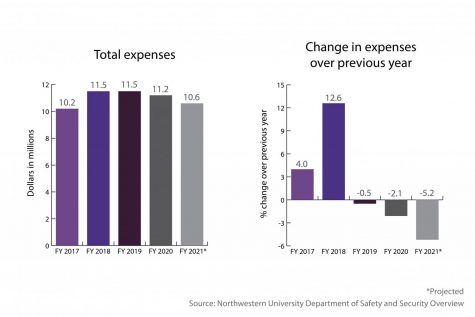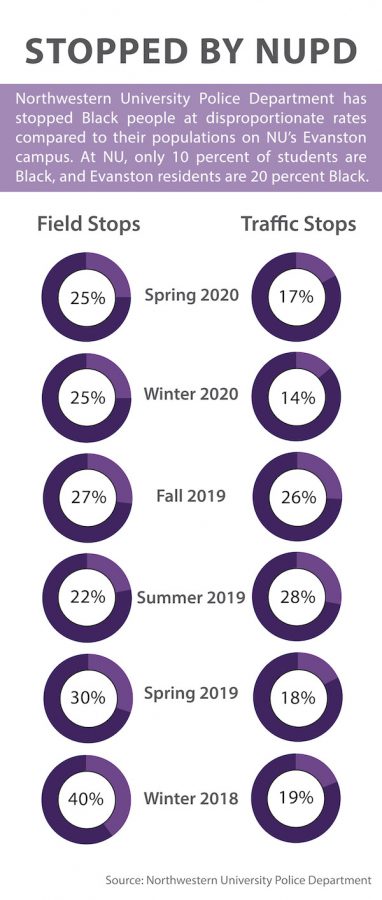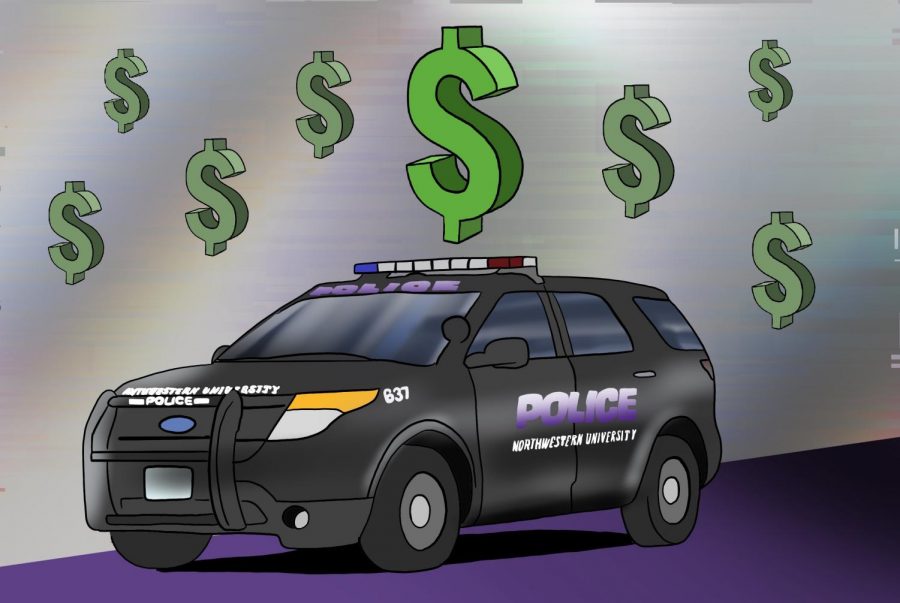Northwestern releases long-awaited NUPD budget review, details $11.2 million in expenses for FY 2020
Illustration by Carly Schulman
In FY 2020, University Police expenses totaled $11.2 million — 90 percent of which went to compensation and external contract staffing. The University projects UP expenses for FY 2021 to be down by 5.2 percent to $10.6 million.
November 17, 2020
Northwestern released a review of University Police on Monday, detailing its role on campus, budget allocations and a slight decrease in spending over the past two fiscal years.
Black undergraduate and graduate students jointly released a June 3 petition that called to sever the University’s affiliated ties with policing entities and to redirect the funds to institutions that serve Black students’ wellbeing. The petition garnered over 8,000 individual signatures and hundreds from student groups, but demands to divest from law enforcement were not met by administrators all summer.
The journey to transparency
Craig Johnson, senior vice president for business and finance, said in a news release that the report establishes an “important step toward improved transparency” between the University and the campus community. The University has an “explicit responsibility,” he said, to protect the safety and well-being of the NU community.
“Together we can listen, reflect and reimagine how to foster campus safety and security in the most holistic and equitable way possible — informed by longstanding concerns of historical inequities in American policing,” Johnson said in the release.
One student involved with NU Community Not Cops questioned the administration’s commitments to transparency and honesty. She said the entire process leading up to the budgetary review’s release was the “opposite of transparent.”
At a July 24 town hall, Provost Kathleen Hagerty said there would be “no problem” disclosing the UP budget and that she would share that information after the meeting. But when NU Community Not Cops followed up with the provost, they wrote they were “met with silence.”
Over the summer, NU Community Not Cops hosted phone and email zaps demanding the University disclose the UP budget. They also began daily actions starting Oct. 12 to advocate for the department’s abolition. With budgetary details, the group wrote it would be able to push for more explicit demands informed by the reality of UP’s involvement on campus.
Breaking down the numbers
In FY 2020, UP expenses totaled $11.2 million — 90 percent of which went to compensation and external contract staffing.
The University projects UP expenses for FY 2021 to be down by 5.2 percent to $10.6 million. This projection takes into account factors like the pandemic’s impact on security needs and overtime costs. According to the report, the University has seen lower staff counts in FY 2021 but increased security needs this quarter.
UP expenditures have grown annually since FY 2011 on average by 2.6 percent, compared to 4.2 percent average growth in NU’s overall expenses each year. Since FY 2018, UP spending has decreased by 7.6 percent due to “University-wide cost containment priorities.”
According to the report, UP spent $8.2 million in FY 2020, or 73 percent of its budget, to pay its 74 employees regular salaries and benefits.
Spending correlates to campus safety needs, such as security incidents that call for “additional vigilance” or the opening of new buildings, according to the release.

Who is on staff and how are they trained?
UP has a hybrid staffing model that consists of 55 percent trained professional police and 45 percent civilian security officers. According to the report, UP aims to provide “professional, courteous and effective” law enforcement services to the NU community.
According to the report, UP staff is more diverse than the average campus police department. Half of UP officers identify as Black, Hispanic or Asian and a third identify as women. UP Chief Bruce Lewis, who is Black, also praised the department’s diversity in a June community dialogue, adding that the department needs to increase anti-racism training measures. However, some critics have noted that diversity training does not mitigate larger issues of systemic racism.
UP staff are also mandated to receive continual training and professional development on topics like unconscious biases and learn how to be more aware of and minimize them, according to the report.
NU police officers have the same enforcement authority and responsibilities as municipal police officers and county sheriffs under the Illinois Private College Campus Police Act. In 2019, the only full calendar year detailed in the report, UP conducted 21,233 premise checks and 13,917 foot patrols.

All UP staff undergo training to cover responding to individuals experiencing a crisis and strengthening community trust and relationships. This includes mental health first aid, de-escalation tactics and procedural justice. UP officers are also trained to connect victims with medical help, mental health services or the Office of Equity.
However, some have criticized universities like NU for performing “wellness checks,” which can involve administrators and police officers checking on students in mental health crises, potentially escalating the situation.
The University does not disclose its budget for Counseling and Psychological Services. However, in 2018, there were over six times as many UP employees across both campuses as CAPS personnel — with just 13 full-time clinical staff on the Evanston campus.
UP’s jurisdiction and role in campus safety
UP is responsible for both the Evanston and Chicago campuses, as well as off-campus University property and contiguous public property. Any “serious” on-campus incidents can be investigated by UP, the Evanston Police Department or Chicago Police Department, though the report does not detail criteria for a serious incident.
The report includes demographic information regarding field and traffic stops, which can occur when UP inquires about “concerning” activity and when someone is pulled over for a “moving violation,” respectively.
[Read our analysis of Northwestern’s relationship with UP and EPD for more.]
UP publishes quarterly reports about all field and traffic stops conducted by its officers in both Evanston and Chicago, which include information about race and gender. For the past six quarters, Black people were stopped disproportionately relative to their population on the Evanston campus.(77 percent of stops in 2019 were of people unaffiliated with the University.)
Most recently, in Spring 2020, Black people made up 25 percent of field stops and about 17 percent of traffic stops in Evanston. For comparison, NU’s freshman class is only 10 percent Black and Evanston’s population is 16.6 percent Black.
In Spring 2020, about 61 percent of field stops and 33 percent of traffic stops were White people. (The sample size of Spring 2020 traffic stops was much lower than previous quarters due to the decrease in campus population density amid COVID-19 closures).

Partnerships with other police forces
The University and EPD are under a mutual aid agreement to assist in emergencies, which grants UP the ability to issue citations and write tickets in some off-campus areas. UP also coordinates with CPD to respond to safety concerns on the University’s Chicago campus. However, there is no formal mutual aid agreement between UP and CPD.
UP is not a member of the Northern Illinois Police Alarm System and cannot request assistance from the organization, but EPD is a member and can call NIPAS for assistance with situations in the city that require their “specialized capabilities.” NIPAS is an inter-municipal police mutual aid organization composed of over 80 suburban police departments across Cook and other nearby counties.
In an email obtained through a Freedom of Information Act request, NIPAS leader Chief David Clark asked the city of Evanston if NIPAS forces could intervene in the NU Community Not Cops demonstrations — and the city agreed.
But at a Saturday sit-in held by Evanston Fight for Black Lives, Ald. Ann Rainey (8th) told protesters City Council wasn’t notified before NIPAS arrived at a protest for the first time this fall. She said she found it “offensive” that NIPAS was present, and encouraged Police Chief Demitrous Cook not to call them in again.
In a letter obtained from a Freedom of Information Act request, Cook thanked the NIPAS Mobile Field Force members that responded to EPD’s calls for “crowd control” assistance for up to 300 protesters.
Though the University cannot directly request assistance from NIPAS, the organization’s presence has been largely felt in campus conversations surrounding policing.
NIPAS officers have guarded University President Morton Schapiro’s home during several recent protests. On Halloween, a NIPAS officer threw one student protester to the ground, pinned her to the sidewalk and zip-tied her hands together while other officers shoved the crowd backward. The officers employed pepper spray and an impact round of what appeared to be pepperballs on the crowd while the protester was being detained.
At a Nov. 9 demonstration, at least 70 police officers were present for a crowd of no more than 60 protesters, including armed officers in riot gear from the NIPAS Mobile Field Force. Officers have also informed students of ongoing police acts of surveillance, including openly recording protesters and following groups of students home after actions.
Email: [email protected]
Twitter: @isabellesarraf
Related Stories:
— Analysis | Northwestern’s relationship with NUPD, EPD
— President Schapiro says Northwestern has “absolutely no intention” to abolish NUPD
— Disarm, defund, disband: Students are marching every day until Northwestern abolishes NUPD


